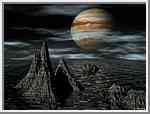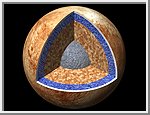











|
Douglas Isbell Headquarters, Washington, DC Sept. 30, 1999 (Phone: 202/358-1753) Jane Platt Jet Propulsion Laboratory, Pasadena, CA (Phone: 818/354-5011) RELEASE: 99-112
Sulfuric acid -- a corrosive chemical found on Earth in car batteries -- exists on the frozen surface of Jupiter's icy moon Europa.
"This demonstrates once again that Europa is a really bizarre place," said Dr. Robert Carlson of NASA's Jet Propulsion Laboratory (JPL) in Pasadena, CA. "Sulfuric acid occurs in nature, but it isn't plentiful. You're not likely to find sulfuric acid on Earth's beaches, but on Europa, it covers large portions of the surface."
The new findings from NASA's Galileo spacecraft are reported in the Oct. 1 issue of the journal Science. Carlson, the principal investigator for the near-infrared mapping spectrometer aboard Galileo, is the lead author of the paper.
 Although there is no evidence of life on Europa, pictures and
other scientific information gathered by the Galileo spacecraft
indicate a liquid ocean may lie beneath Europa's icy crust. Water
is one key ingredient essential for life.
Although there is no evidence of life on Europa, pictures and
other scientific information gathered by the Galileo spacecraft
indicate a liquid ocean may lie beneath Europa's icy crust. Water
is one key ingredient essential for life.
At first, Carlson thought the spectrometer's findings of sulfuric acid on Europa would quash any talk that life might exist there. "After all, even though we know there are acid-loving bacteria on Earth, sulfuric acid is a nasty chemical," he said. Those thoughts were quickly negated by a colleague, Dr. Kenneth Nealson, head of JPL's astrobiology unit, who was excited by the findings.
"Although sulfur may seem like a harsh chemical, its presence on Europa doesn't in any way rule out the possibility of life," Nealson said. "In fact, to make energy, which is essential to life, you need fuel and something with which to burn it. Sulfur and sulfuric acid are known oxidants, or energy sources, for living things on Earth. These new findings encourage us to hunt for any possible links between the sulfur oxidants on Europa's surface, and natural fuels produced from Europa's hot interior."
"These findings have helped solve a puzzle that has been nagging at me for a long time," Carlson said. "Data gathered by the spectrometer during observations of Europa had shown a chemical that we couldn't identify. I kept wondering, 'What the heck is this stuff?' Lab measurements now tell us that it is sulfuric acid, and we can start investigating where it comes from and what other materials might be there." For example, some reddish-brown areas on Europa might be caused by sulfur that co- exists with the sulfuric acid.
 One theory proposed by Carlson is that the sulfur atoms
originate with the volcanoes on Jupiter's fiery moon Io, with the
material being ejected into the magnetic environment around
Jupiter and eventually whirled toward Europa. Another idea is
that the sulfuric acid comes from Europa's interior, beneath the
moon's icy crust, ejected by sulfuric acid geysers or oozing up
through cracks in the ice.
One theory proposed by Carlson is that the sulfur atoms
originate with the volcanoes on Jupiter's fiery moon Io, with the
material being ejected into the magnetic environment around
Jupiter and eventually whirled toward Europa. Another idea is
that the sulfuric acid comes from Europa's interior, beneath the
moon's icy crust, ejected by sulfuric acid geysers or oozing up
through cracks in the ice.
Another theory comes from Carlson's co-author, Professor Robert Johnson of the University of Virginia in Charlottesville, who noted that sodium and magnesium sulfates may have leached onto Europa's surface from underground oceans and then were altered by the intense radiation field. This would produce the frozen sulfuric acid and other sulfur compounds. The new finding is also consistent with earlier Galileo spectrometer data analyses reported by Thomas McCord of the University of Hawaii and other members of the instrument team, who suggested that sulfate salts of this type were present on Europa.
Carlson, Johnson and co-author Mark Anderson, a chemist in JPL's Analytical Chemistry Laboratory, plan to study Jupiter's largest moon, Ganymede, to see if it also contains sulfuric acid.
The near-infrared mapping spectrometer works like a prism to break up infrared light not visible to the naked eye. Scientists can study the resulting light patterns to determine what chemicals are present, since different chemicals absorb infrared light differently.
Galileo has been orbiting Jupiter and its moons for nearly four years. More information on the Galileo mission is available on the World Wide Web at:
Views of the Solar System Copyright © 1997-2000 by Calvin J. Hamilton. All rights reserved. Privacy Statement.